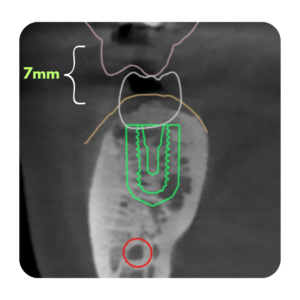There is a lot of talk about Implant Neck designs recently.
Some are saying that smooth is better. Others say that rough all the way to the platform is best.
And still others are bringing back an old classic design: the tissue level implant.
Implants can be classified as bone level and tissue level.
Bone level is great because the implant is completely submerged and the color of the implant body is totally masked. This allows you a plethora of restorative options.
Tissue level is a bit trickier. For tissue level implants, it is more likely that the color of the implant will show through. It can be more difficult to achieve an esthetic outcome, especially if the tissue recedes at all.
But what about cleansibility?
The study that we’re looking at today, asks us to evaluate the Implant-Abutment interface.
For bone level implants, this interface is hidden. It lies deep and it is harder to clean.
For tissue level implants, it’s out there in the open. It can be accessed by the patient to clean. And some people think that it may make the fight against peri-implantitis an easier battle.
I guess their thinking goes “Our implants won’t lose bone. BUT IF THEY DO, you can clean it.”…
[mepr-show if=”loggedout”]Sign Up or login to Implant Ninja Dojo to read the rest of this article.[/mepr-show]
[mepr-show if=”loggedin”]So, can tissue level implants be as successful in maintaining healthy peri-implant tissues as bone level implants?
This Retrospective analysis study by Lorean et al 2021 looked at this.
They used a tissue level implant from Adin that has angulations built into it.
This is the implant:
Between 2008 and 2015 three doctors in three different private clinics placed 185 tissue level implants for full arch restorations.
They evaluated the implants at 1,5, and 10 years.
Here’s what they found:
The bone loss seen on these implants is at least as good as with bone level implants.
A summary of the findings:
- 185 implants
- 4 failures
- 35 Implants with Bleeing on Probing
- Average bone loss: 0.260 +/- 0.903
That all seems like good news. I would be a little bit apprehensive to take all of this as set-in-stone for a couple of reasons:
- A full account of the data was not provided. Therefore I am not sure how some of the conclusions were calculated. How did they calculate a 97.8% success rate?
- This report is very relevant for full arch, but we should be careful how we translate this to single implants.
In the discussion section, the authors suggest that, angled implants have a higher success rate than straight implants. And angled abutments have high complications. Therefore we should use angled implants instead of angled abutments.
I can see how this argument might be constructed for full arch, but there is no way this would be applicable to single implant restorations. Especially as the supporting literature they cite is mainly referencing full arch.
So, of course, more studies are needed. But as for now, what we can say is that for full arch implants, it may not be a bad idea to consider tissue level angle correcting implants. They seem like they would be easier to keep clean, like the folks in this study were able to show.
I, for one, would be happy to ditch those annoying multi unit components. Although I imagine getting the timing right for innately angled implants might have its own learning curve too!
The Article that we read:
Full-Mouth Rehabilitation Using a Tissue-Level Angled-Head Dental Implant System: A Retrospective Analysis with Long-Term Follow-Up
Adi Lorean, DMD/Anahat Khehra, BMSc/Jean Benatouil, DMD/Gideon Hallel, DMD, MPA/Liran Levin, DMD, FRCD(C), FIADT, FICD
DOI: 10.11607/jomi.9433[/mepr-show]




Responses